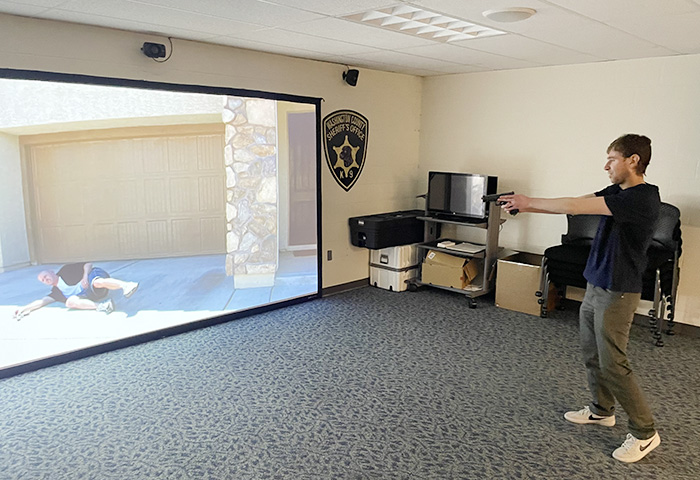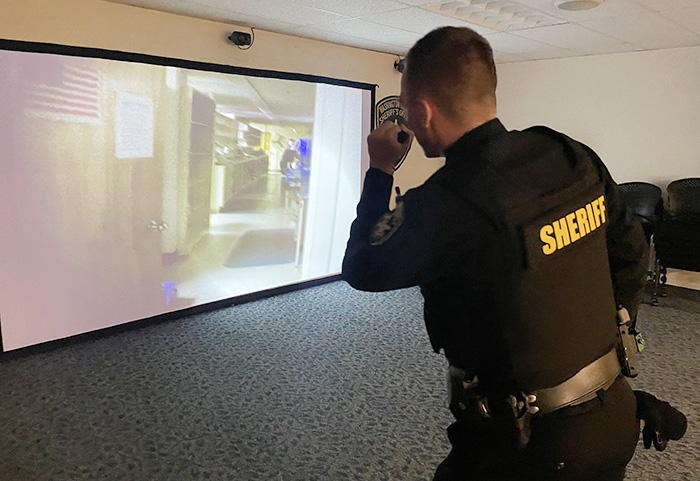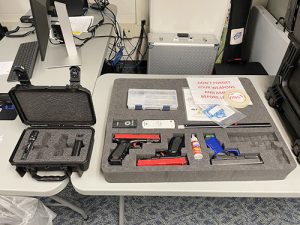By Ben Westcott, Chronicle Staff Writer
The Washington County Sheriff’s Office has a new piece of technology that helps its officers train like never before.
The Multiple Interactive Learning Objectives Range Pro Interactive Force Simulator, acquired in February, can virtually put officers in thousands of scenarios they might encounter in their job, so they can practice reacting to situations.

Photo/Captain Anthony LeClaire, Washington County Sheriff’s Office
Some of the situations are very dangerous, like responding to an active shooter call. Others are less intense, like talking to a driver who is being obstinate after getting pulled over by a cop. “In a classroom setting, you can’t teach what this teaches,” Sheriff Jeffrey Murphy said. “You’re emotionally immersed in a situation, and it’s realistic.”
The simulator shows content on a 120-inch screen, with audio. Officers wield a real Glock pistol, taken apart to shoot laser beams instead of bullets. The feedback or ‘action’ of the gun feels real when fired.
The laser technology can be incorporated into the department’s AR rifles as well.
The shot beams register on the screen, which can make the system good for target practice without wasting real ammunition. If there are two officers using the simulator simultaneously, the program can tell which one has which gun.
The simulator also comes with a flashlight that officers can use to light up the virtual scene, as they would in a real-life scenario taking place in darkness.
Tasers for the simulator are on backorder but should be coming soon.
While the officers are training with the simulator, they act like it’s a real life situation, talking to the character on the screen, whether it be a domestic violence victim, someone acting aggressively, or even another cop not performing his or her job correctly.

An operator at the computer can have the virtual characters respond differently, depending on how the officer acts in the simulation or which lesson the operator aims to teach through the program.
“The goal of the training is to discuss it afterwards,” Captain Anthony LeClaire said. “What could you have done differently, what could you have done better? It’s about de-escalation. That’s really the whole goal of the system.”
Capt. LeClaire said, “For every scene where somebody can pull a gun, there are just as many scenes where there are other options to do. That’s not the option that anybody wants. We want to train on the other options, and how not to get to that option.”
In addition to the huge amount of possibilities that come with the system, the Sheriff’s Office can create its own situations by using body cameras in local buildings, like area schools.
“We can film different scenarios in different county buildings,” Sheriff Murphy said. “It’s a great piece of equipment to have, especially with de-escalation. It’s not all about shooting. It’s kind of more about the opposite.”
The total cost of the system, install, training and accessories was $55,368.

Sheriff Murphy said he’s long been trying to get a simulator but was prohibited by the cost. The department was finally able to cover the cost entirely through a State Division of Criminal Justice Services grant through Assemblywoman Carrie Woerner and a State Homeland Security grant obtained by Capt. LeClaire that he said is funded by the US Department of Homeland Security and FEMA and administered by the New York State Division of Homeland Security and Emergency Services on behalf of FEMA.
While the department has only had the simulator for a couple months, Capt. LeClaire said he is already noticing positive effects from its use. “You’re putting people through different scenarios, and the discussions that have come up have really been beneficial so far,” he said.
“Maybe an officer you’re with is doing something that he shouldn’t be doing. We want to see what our officers are going to do and how they’re going to react, and then we’ll talk about it.”
Through conversations with the characters on the screen, officers can practice developing a rapport with people who are dealing with mental problems in an effort to better help them.
“Obviously, we deal with a lot of mental health calls,” Capt. LeClaire said. “It’s just the way that society is today. So this is good training for our guys in how to interact with different people with different issues.”
Sheriff Murphy said research indicates that more practice with the simulator can lead to more peaceable outcomes in the real world. “They say that an officer who’s confident in his abilities with a simulator is less likely to use force,” the sheriff said.
Before the Sheriff’s Office acquired this technology, officers would rarely if ever train on simulators after leaving the Police Academy. Now, Sheriff Murphy plans to have all of his officers, regardless of experience level, spend time with it.
“It’s all well and good to lecture you about de-escalation and things like that, but interacting with the screen and then being able to change the outcome is priceless,” the sheriff said.
Copyright © 2024 Lone Oak Publishing Co., Inc. All Rights Reserved
 Glens Falls Chronicle Serving the Glens Falls/Lake George region; Warren, Washington and northern Saratoga counties since 1980
Glens Falls Chronicle Serving the Glens Falls/Lake George region; Warren, Washington and northern Saratoga counties since 1980

